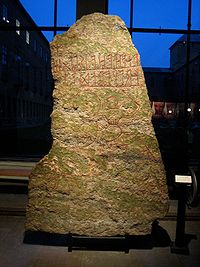- Möjbro Runestone
-
Runestone 
Name Möjbro Runestone Rundata ID U 877 U Country Sweden Region Uppland City/Village Möjbro Produced 400-550 Runemaster Unknown
Text - NativeProto-Norse : Frawaradaz <anahaha> is slaginaz.[1] Text - English Frawaradaz <anahaha> is killed.[1] Other resources Runestones - Runic alphabet
Runology - Runestone stylesThe Möjbro Runestone is a runestone that is designated as U 877 in the Rundata catalog and is inscribed in Proto-Norse using the elder futhark. It was found in Möjbro, which is about 8 kilometers north of Örsundsbro in Uppsala County, Sweden, which is in the historic province of Uppland. The runestone is presently on display at the Swedish Museum of National Antiquities in Stockholm.
Contents
Description
The Möjbro Runestone is notable not only for being one of few runestones in Proto-Norse, but also for showing what is considered to be an artistically crafted image of a rider on a horse with two dogs. It is believed to have been inspired by continental Germanic images of victorious warriors on horses and that it ultimately derives from late Roman Empire era art.[2]
Several interpretations have been put forth for the inscription,[3] which, when read from right to left, is transliterated into Latin letters as frawaradaz anahaha is| |slaginaz.[1] However, the only thing that can be said with certainty on the interpretation of the inscription is that Frawaradaz is the name of a man, but even the interpretation of the name is debated.[4] The most common view is that the runestone is a memorial and that it says that Frawaradaz was slain.
The dating of the inscription varies between 400 AD and 550 A.D. Although the stone has been known since the initial surveys of runestones in Sweden during the 1600s,[2] it exact original location is not known.[5] While the runestone is 2.46 meters in height and made of granite, it is considered to be fragile. To protect the stone and its shallow inscription, it was moved in 1948 from Möjbro to the Swedish Museum of National Antiquities.[5]
References
- ^ a b c Project Samnordisk Runtextdatabas Svensk - Rundata.
- ^ a b Friesen, Otto von (1949), "Möjbro-Stenen", Fornvännen (Swedish National Heritage Board) 44: 287–309, ISSN 1404-9430, http://fornvannen.se/pdf/1940talet/1949_287.pdf
- ^ "12 Möjbro Inscription Interpretations". Kieler Runenprojekt. Deutsche Forschungsgemeinschaft. http://www.runenprojekt.uni-kiel.de/abfragen/standard/deutung2_eng.asp?findno=95&ort=Möjbro&objekt=runsten,%20grovkornig%20granit. Retrieved 2010-01-15.
- ^ Peterson, Lena (1994). "On the Relationship Between Proto-Scandinavian and Continental German Personal Names". In Düwel, Klaus. Reallexikon der Germanischen Altertumskunde. Berlin: Walter de Gruyter. pp. 152–153. ISBN 3-11-014328-3. http://books.google.com/books?id=yIYYisHnijsC&printsec=frontcover&source=gbs_navlinks_s#v=onepage&q=&f=false.
- ^ a b Jansson, Sven B. F. (1952), "Möjbrostenens Ristning", Fornvännen (Swedish National Heritage Board) 47: 124–127, ISSN 1404-9430, http://fornvannen.se/pdf/1950talet/1952_124.pdf
Other sources
- The article Möjbrostenen in Nationalencyklopedin (1994).
External links
Categories:- Proto-Norse
- Runestones in Uppland
Wikimedia Foundation. 2010.
